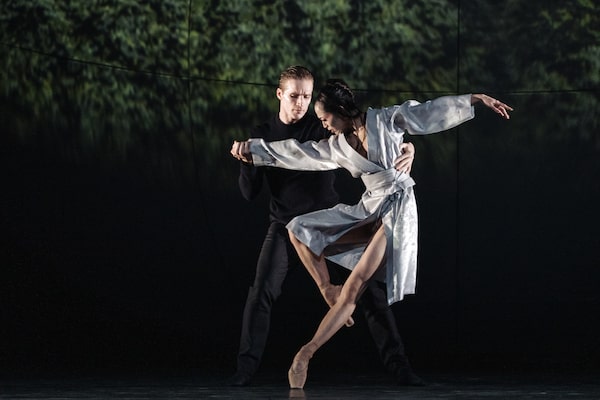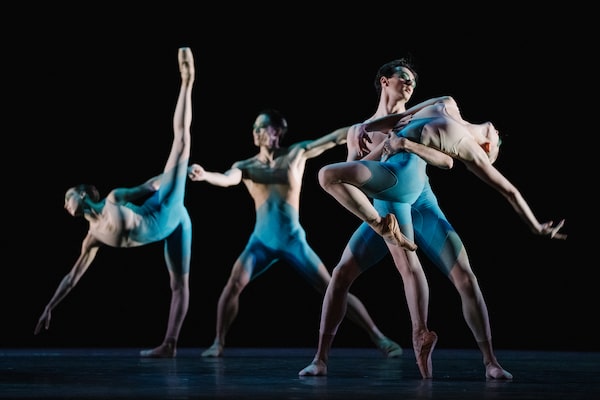
In choreographer Wayne McGregor’s tortuous new adaptation of Margaret Atwood’s MaddAddam Trilogy, the pigoons are portrayed as giant puppets, taking BlyssPluss pills leads to an epic dance party and the best way to fight off CorpSeCord troopers is with razor-sharp châinez turns.Karolina Kuras/National Ballet of Canada
- Title: MADDADDAM
- Choreographer: Wayne McGregor
- Composer: Max Richter
- Creative Consultant: Margaret Atwood
- Dancers: Siphesihle November, Spencer Hack, Koto Ishihara, Svetlana Lunkina, Harrison James, Heather Ogden, Alexandra MacDonald, Tanya Howard, Tina Pereira, Jenna Savella, Jordana Daumec, Piotr Stanczyk, Donald Thom.
- Company: National Ballet of Canada, London’s Royal Ballet co-commission
- Venue: Four Seasons Centre for the Performing Arts, 145 Queen Street West
- City: Toronto
- Year: November 23 – 30, 2022
In choreographer Wayne McGregor’s new adaptation of Margaret Atwood’s MaddAddam trilogy, the pigoons are portrayed as giant puppets, taking BlyssPluss pills leads to an epic dance party and the best way to fight off CorpSeCorps troopers is with razor-sharp chaînés turns.
MADDADDAM, which had its world premiere with the National Ballet of Canada on Wednesday night, will likely mesmerize fans of Atwood’s speculative fiction while leaving balletomanes mildly disappointed. Like symphonic concerts of video-game music, MADDADDAM shows off the company’s skills for a targeted audience without marking a great leap forward for the art form.
And who wants to see art imitate life in 2022? As Atwood’s novels are about survivors of a global pandemic, it’s a legitimate question. For those who do not, The Nutcracker is coming soon. For those who brave MADDADDAM, in development since 2017 – long before the COVID-19 pandemic – prepare to alternatively be horrified, confounded and amazed.

MADDADDAM shows off the National Ballet of Canada's skills for a targeted audience without marking a great leap forward for the art form.Karolina Kuras/National Ballet of Canada
Although the prophetic horrors of The Handmaid’s Tale are better known (and were depicted in ballet prior to Hulu taking them on), many of Atwood’s speculations in Oryx and Crake, The Year of the Flood and MaddAdam have come to fruition since the books were published in 2003, 2009 and 2013. Power increasingly rests with a handful of tech billionaires, the world is facing new outbreaks of war and genetically engineered meat is very much a thing.
Even being terrorized by feral pigs, whose populations have exploded in Canada since MaddAddam was published, is a fearful reality represented onstage by amorphous, gorilla-like puppets.
In Atwood’s novels, humankind’s folly begins with the creation of “pigoons,” genetically modified hogs developed for human organ replacement. Society soon becomes siloed into hyper-secure compounds where elite scientists compete to perfect the human race, while in the outside world, “pleebands” subsist in the ruins of violent cities and suburban shopping malls. Then comes the “waterless flood” of the pandemic, wiping out nearly all humans on earth.
As in the books, the central character in the ballet is “Snowman the Jimmy,” a plague survivor portrayed on opening night by a lithe Siphesihle November (a second cast goes onstage starting with the Saturday matinee). McGregor neatly milks the love triangle between Jimmy and Crake, his childhood friend turned tech guru, and Oryx, a porn star they encounter online as teens, in a series of pas de trios. There’s nothing X-rated about the dancing, although an exquisite Koto Ishihara does tuck both feet inward each time she’s awkwardly lifted by one of the men. Crake (Harrison James) is unmistakably dressed in a Steve Jobs black turtleneck, while Jimmy wears thrift-store rejects.

A better development of female leads, their friendship and their fortitude, would have helped to balance to the show’s overall gender dynamics.Karolina Kuras/National Ballet of Canada
British fashion magnate Gareth Pugh gets credit for the spot-on costumes, and it should be said that while there is considerable nudity in Atwood’s books, no dancers appear naked onstage, nor is their wardrobe limited to togas made from scavenged sheets.
Each act of the ballet inhabits a separate choreographic world, rather than a one-to-one correlation of the novels. The more you know before entering the theatre, the better. In Act 1, “The Castaway,” overlapping narratives introduce Jimmy, Crake and Oryx as well as the pleebands who populate The Year of the Flood. McGregor’s storytelling relies heavily on projections by Ravi Deepres, a filmmaker he has collaborated with on other dance/technology fusions.
In both Act I and Act II (“The Extinctathon”), McGregor could have done much more to develop the friendship between a trio of female resisters: Toby (the impeccable Heather Ogden), Amanda (a bold Jenna Savella) and Ren (a sequined, slinky Tanya Howard). A better development of these female leads, their friendship and their fortitude, would have helped to balance to the show’s overall gender dynamics.
Instead, he emphasizes Amanda’s rape at the hands of three punky-looking villains Atwood calls Painballers. Male dancers pile on Savella and then remain still as footage of wolves tearing into prey appears to the right on a scrim. It’s one of the more horrific scenes you will ever see onstage, and it defies a call for choreographers (most of whom are men) to stop staging gang rape in ballet.
Act II appropriates the video-game aesthetic to depict the war between CorpSeCorps (soldiers for the compounds) and the resistance fighters, as well as flashing back to the chaos that kills off Oryx and Crake. Green text announces the years and plotpoints in nonlinear order. Composer Max Richter forgoes the orchestra for an electronic pulsing, buzzes and static. Cutting through the noise like strobe lights are the dancers, using tight, quick chaînés turns to throttle across the stage.
The scenes in Act III could be seen as a meditation on the utopia Atwood’s characters envision at the trilogy’s close.Bruce Zinger/National Ballet of Canada
The pace is adrenaline pumping, for both the audience members and the dancers, who are well rehearsed and deftly avoid crashing into postapocalyptic props.
Only once – in the opening of Act III, “Dawn” – does McGregor revert to his choreographic hallmark of herky-jerky neck movements, and that spinal serpentining happens in an appropriately otherworldly solo for Genevieve Penn Nabity.
Hunched, angular solos appear in all three acts, but Act III is devoted mostly to ensemble dancing. The corps wear blue-blotched leotards and striking eye makeup, fluidly winding and unfurling like a Spirograph. The orchestra returns, integrating a lush descending cadence with electronic sound. These sequences are gorgeous but not groundbreaking, perhaps a meditation on the utopia Atwood’s characters envision at the trilogy’s close.
In the ballet’s final moments, McGregor effectively relies on analogue theatre magic to emotionally engage his audience. Trios of dancers use a handful of props to create marionettes that represent three characters. (One is Jimmy, the other two are probably Toby and her lover, although that’s somewhat unclear.) Storytelling, this scene wisely asserts, is a universal human necessity.
In a voiceover that’s unfortunately distorted beyond clear comprehension, a child’s voice recounts the creation myth of Oryx and Crake. Then the dancers pass Jimmy’s distinctive red cap to a young girl left alone onstage in the spotlight – a child to represent an innocent future, free from the horrors of Atwood’s recent past.